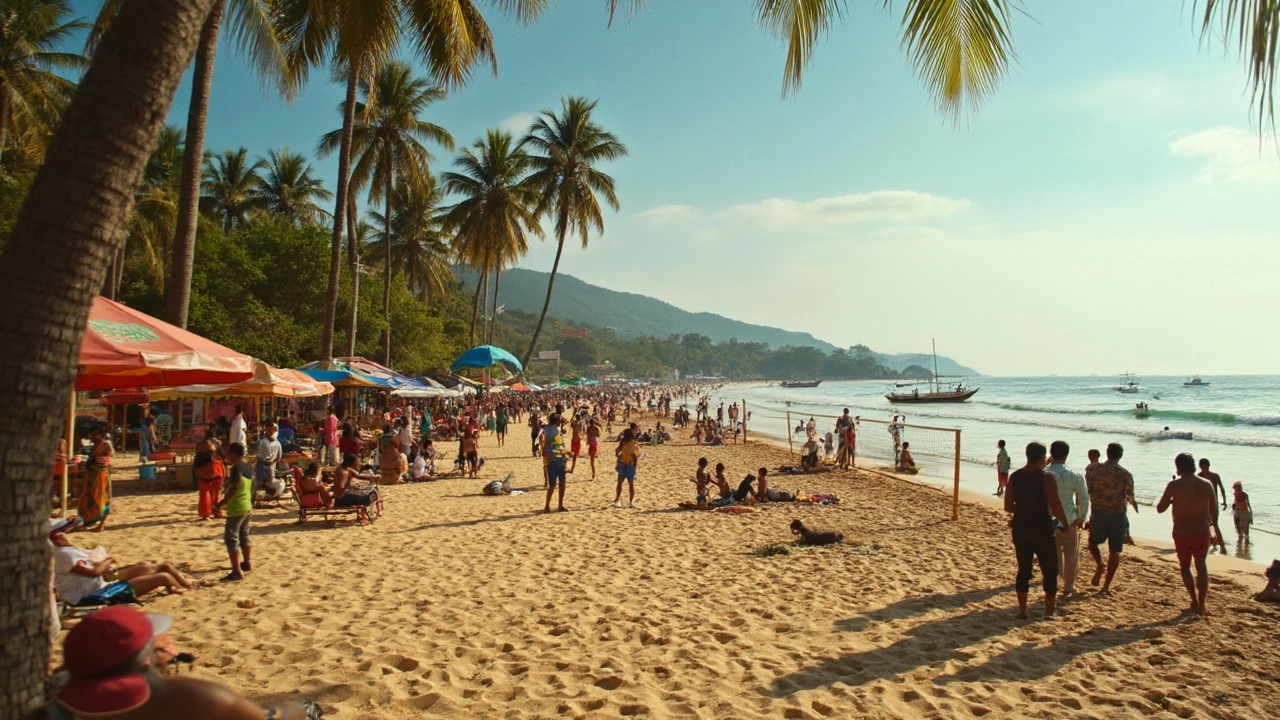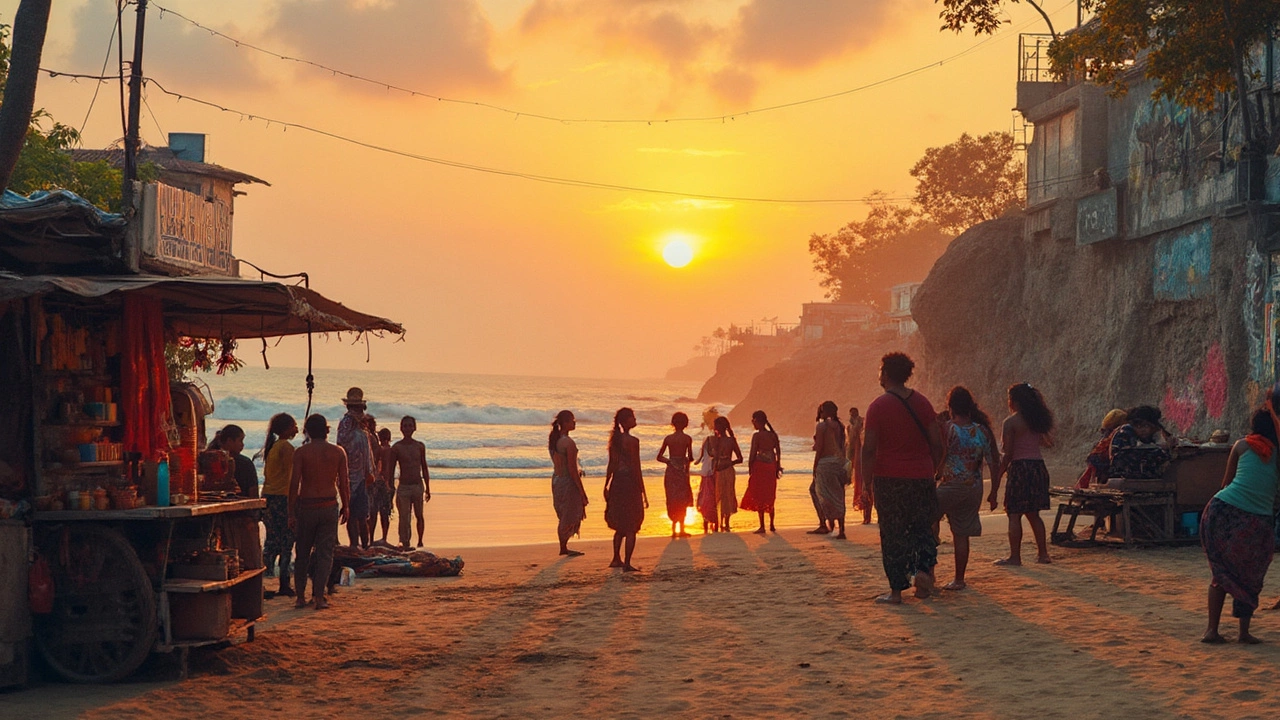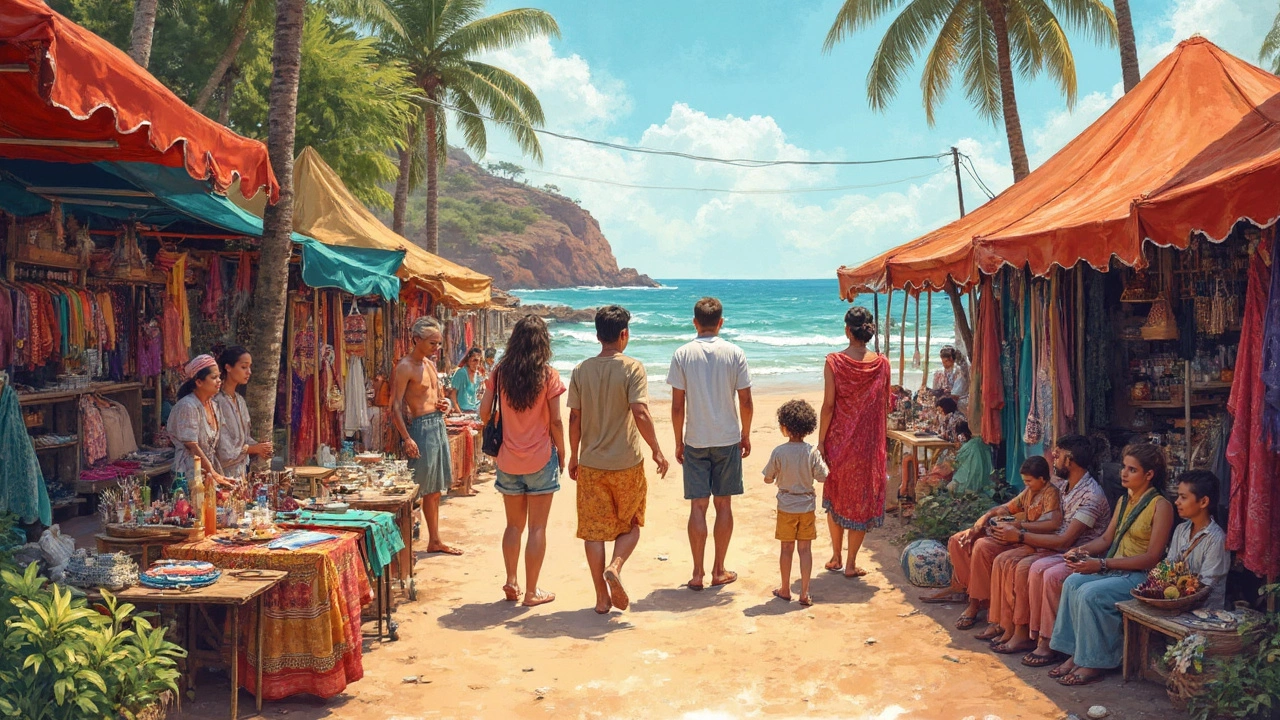Foreigners Beach in Goa: Which One Actually Deserves the Name?
 May, 23 2025
May, 23 2025
Ask anyone with a backpack stuffed in a hostel locker about Goa’s so-called ‘Foreigners Beach’ and most will point you straight to Anjuna Beach. This place has had an international rep for decades—not just because it’s postcard-pretty, but because it’s where the global traveler crowd truly feels at home. Long before ‘work from beach’ was a thing, Anjuna was pulling in hippies, artists, and adventurers from Europe, Russia, Israel, and beyond.
It’s not just a nickname for the sake of sounding cool—show up at sunset and you’ll notice the crowd is a wild mix of languages, hair colors, and travel stories. Unlike other Goa beaches that lean super-local or cater mostly to Indian families, Anjuna feels like a stopover on a long, windy road around the world. The beachside shacks actually serve up food you can recognize even if your taste buds aren’t used to spicy Indian curries. You’ll find wood-fired pizzas, falafel wraps, or even German-style pastries just steps from your towel.
If you’re looking for beach huts with conversations in German, techno beats at night, or yoga classes run by someone who’s definitely not from Goa, Anjuna is the spot. At the same time, the vibe has shifted over the years. Some travelers complain it’s a bit more commercial these days, but the easygoing, global feel hasn’t disappeared. If you want a place where nobody bats an eye at your accent or flip-flops, this is the right patch of sand.
- The Story Behind the Name
- Why Anjuna Stands Out
- What the Crowd is Really Like
- Best Things to Do Nearby
- Tips for Your First Visit
The Story Behind the Name
The tag ‘Foreigners Beach’ wasn’t just dreamed up by tour operators—it’s actually rooted in how the crowds in Goa shifted, starting back in the 1960s. While loads of local families stuck to spots like Calangute or Baga, international travelers headed to quieter, more laid-back strips of sand. Anjuna popped up on the map because it was almost off the grid, far enough away from the major hotels, and the locals weren’t used to seeing packs of backpackers soaking up the sun with guitars or sketchbooks. Word spread fast in the ‘Hippie Trail’ era, and suddenly Anjuna was the go-to for those who wanted to escape big tourist traps.
Locals started calling it ‘Foreigners Beach’ because the vibe was totally different. You could hear more English, German, and Russian than Konkani or Hindi, which still surprises first-timers. Fast forward to the late 90s and early 2000s, and the nickname stuck even as more beaches opened up to tourists. Check out this quick comparison of visitor trends over the years:
| Year | Estimated Share of Foreign Tourists (%) | Dominant Nationalities |
|---|---|---|
| 1970 | 80 | Europeans (mainly British, German) |
| 1995 | 70 | Europeans, Israelis, Russians |
| 2015 | 60 | Russian, Israeli, Western European |
| 2024 | 58 | Russian, Ukrainian, Israeli, European |
So is Anjuna still worthy of being called the foreigners beach Goa? The numbers speak for themselves—international tourists flock here more than almost anywhere else in the state. But don’t think it’s just about passports. The whole local scene—from shops selling macrame and dreadlock beads to authentic falafel cafes—keeps that global energy alive.
The name also cleared up confusion among cab drivers and first-time visitors, since it instantly pointed people to where the ‘foreign crowd’ hung out. Even now, if you hop in a taxi from Panjim and mention ‘foreigners beach,’ nine times out of ten you’ll end up at Anjuna.
Why Anjuna Stands Out
There are a ton of beaches in Goa, so why does Anjuna Beach always get called the foreigners beach Goa? Simple: it started with the hippie trail in the late '60s and never really stopped. This place was one of the first in India to put up with folks arriving in battered vans from Europe, setting up drum circles, and bartering for handmade jewelry. Even now, walk along Anjuna’s main drag and you’ll see signs in Russian, German, and Hebrew, plus menus with quinoa bowls next to spicy vindaloo.
The vibe is totally geared for travelers who want to relax but not totally blend in. You’ll notice more backpacker hostels, live-music cafes, and coffee shops where it actually feels normal to fire up your laptop for a few hours. Nothing too formal. The legendary Anjuna Flea Market happens every Wednesday and pulls in foreigners and locals alike—some estimates claim over 30% of the stalls are run by international vendors during peak season. That’s rare for anywhere in India.
- The nightlife is actually lively without the pretentious club scene—think beachfront bars with fire shows and trance music, but you won’t get weird looks for bringing your kids along for early dinner.
- It’s super easy to meet other travelers and join up for scooter rides to hidden swimming holes or waterfalls close by.
- A lot of yoga retreats and alternative therapies started in Anjuna before they spread all over India. There’s always a drop-in class or an open-air massage table steps away from the beach.
If you like numbers, look at the crowd makeup from early 2024 based on tourism board reports and a couple of local hostel owners:
| Visitor Type | Estimated % (Peak Season) |
|---|---|
| International Tourists | 40% |
| Indian Tourists | 50% |
| Locals/Goans | 10% |
This is way higher for foreign travelers than most other beaches in North Goa. Whether you’re there for a week or just a sunset beer, Anjuna’s international flavor really does set it apart. If you ever get a chance, try the German bakery near the beach—Aria loved the chocolate croissants way more than the sandcastles, and Maya still talks about the live music under the palm trees.

What the Crowd is Really Like
If you get to Anjuna Beach on any given afternoon, especially from November to February, you’ll notice the crowd is nothing like what you’d see at other Goa beaches. This spot pulls a wild mix of people from all over the world. There are groups of young backpackers staking out sunbeds, digital nomads with laptops, yoga lovers stretching by the water, and families—sometimes with kids running around, like mine.
Unlike beaches like Calangute, where you see mostly Indian tourists, Anjuna feels genuinely international. According to the Goa Tourism Department’s last released data, foreign tourists made up over 55% of the visitors in the northern beach belt during peak season, and Anjuna is a central piece of that. Russians, Israelis, Brits, Germans—the list goes on. The crowd is usually in their 20s to 40s, but you’ll spot the older hippies who never left since the '70s too.
| Nationality | Estimated Share in Foreign Visitors (Peak Season) |
|---|---|
| Russian | 32% |
| European (UK, Germany, France, etc.) | 29% |
| Israeli | 18% |
| Others (Americans, Aussies, etc.) | 21% |
The vibe is chill but lively. Don’t be surprised if you hear a mixture of languages in conversations around you, from Russian to Hebrew. After sunset, Anjuna’s legendary beach parties crank up, drawing in DJs and electronic music fans. The foreigners beach Goa reputation isn’t just a myth—places like Curlies and Shiva Valley get so packed with international travelers, it sometimes feels like you’ve wandered into an Ibiza afterparty.
But there’s more to the crowd than the party scene. On the quieter side of the beach, you’ll meet yoga teachers, remote workers, and traveling families. Shops line the streets selling everything from Turkish jewelry to vegan snacks. The market on Wednesdays turns into a cultural melting pot. If you like talking to strangers and swapping travel stories, you’ll fit right in. If you’re more into peace and quiet, just stick to the southern end early in the morning—the party people are still asleep.
Best Things to Do Nearby
If you’re hanging around Anjuna, there’s way more to do than just lounge on the sand. This area is packed with stuff you won’t want to miss, whether you’re here for the vibe or just want to see what makes the foreigners beach Goa scene so addictive.
- Check out Anjuna Flea Market: Every Wednesday, the beach transforms into a mashup of color, noise, and wild deals. You’ll spot handmade jewelry, quirky souvenirs, vintage clothes, and food stalls with flavors from all over. Bring cash and be ready to haggle.
- Party at beach shacks: Curlies and Shiva Valley are legendary if you’re chasing Goa’s nightlife. The music doesn’t get old until sunrise, and the DJ sets often draw folks from all corners of the globe.
- Splash in natural beauty: Walk north for five minutes and you’ll hit Vagator Beach. It’s quieter—think red cliffs, palm trees, and a great spot for sunset photos. Or, drive up to Arpora for the Saturday Night Market. It opens at 6pm and sticks around 'til midnight.
- Try water sports: From November to March, you can do parasailing, banana boat rides, or even take a jet ski for a spin. Local operators charge around ₹500–₹1,200 per session, depending on what you pick.
- Get your yoga fix: Dozens of studios in the area offer drop-in classes. Many are run by international teachers, and some even sit right on the beach.
- Grab a bite at famous cafés: Artjuna Cafe and Baba Au Rhum are top picks. Think smoothie bowls, Israeli breakfast, and fresh coffee that’s way better than the instant stuff you get in most shacks.
Here’s a quick look at popular spots near Anjuna Beach and what they’re best for:
| Place | Distance from Anjuna Beach | What To Expect |
|---|---|---|
| Anjuna Flea Market | 100 m | Shopping, street food, live music |
| Vagator Beach | 2 km | Peaceful vibe, great for sunset |
| Arpora Night Market | 5 km | Late-night shopping, food trucks, performances |
| Curlies Beach Shack | 500 m | All-night parties, varied food & drinks |
| Artjuna Café | 1 km | Healthy food, smoothie bowls, relaxed crowd |
If you’ve got kids with you like I often do, stick around during the day for low-key fun and pop into a café with a play area. At night, it’s smarter to avoid the party spots if you’re not in the mood for loud music and crowds. The area is safe, but watch your bags and skip carrying tons of cash. If you’re renting a scooter for the day, keep your helmet on—cops do check, and fines can bite.

Tips for Your First Visit
Picking the right side of Anjuna Beach matters more than most people think. The stretch closer to the flea market is always going to be packed and a touch noisier, but it is the heart of the action. The southern curve is quieter if you want a nap or a low-key sunset.
If you show up hungry, focus on the classic beach shacks first. Shacks like Curlies, Shiva Valley, and Eva Café have been drawing international crowds for decades and serve everything from breakfast smoothie bowls to locally-caught seafood. They’re open most of the year, just remember that most shacks shut down during monsoon (June to September).
- Arrive early for a good sunbed—stragglers end up closer to the rocks and less shade.
- The flea market is only open on Wednesdays, and people actually fly in just for it. You can find handmade jewelry, leather bags, vintage clothes, and street food. Bring cash—lots of stalls don’t accept cards or even UPI.
- If you’re planning to swim, know that the current can get surprisingly strong, especially post-monsoon. Stick to the flagged zones.
- Keep an eye on your stuff. Petty theft isn’t crazy-common but leaving your phone unattended isn’t a great idea anywhere in Goa.
Weather is a big deal when it comes to planning. The best time for visiting is November to March; this is when foreigners beach Goa is alive and nearly every shack is open. Daytime highs hover between 28°C to 32°C, while nights are breezy and comfortable. Here’s a quick cheat sheet on what to expect each season:
| Season | Temperature (°C) | Rainfall | Crowd Level |
|---|---|---|---|
| Nov - Mar | 28-32 | Low | High (mostly international & Indian) |
| Apr - May | 32-35 | Very Low | Medium |
| Jun - Sep | 26-32 | Very High | Low |
As Lonely Planet puts it,
"Anjuna Beach remains the epicenter for global travelers who want a bit of everything—sun, good food, and a steady hum of music and energy every night."
If you’re traveling with kids (like I do with Aria), stock up on sunscreen and snacks before heading out, since the minimarts nearby are small and can get pricey. For anyone new to Goa, skip the taxis lined up outside and order a ride through a local app or rent a scooter—just make sure you have an international license.
The golden rule here? Don't try to do everything at once. Take a slow stroll, strike up a chat at the shacks, and actually enjoy the scene. This way, you get the real sense of what draws so many travelers from all over the world back to Anjuna year after year.